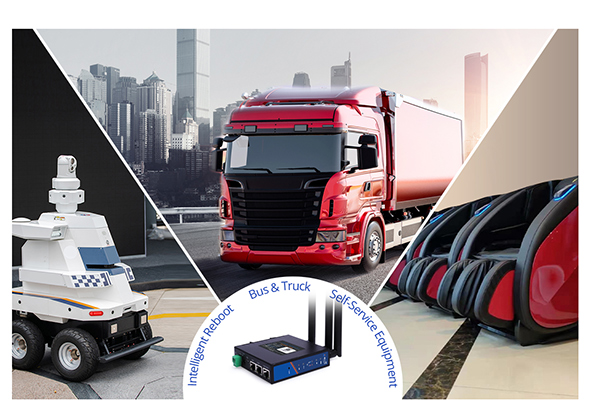Amidst the global wave of digitization, Industrial Internet of Things (IIoT) technology is bringing unprecedented transformation to traditional industries. Among them, Lte 4g router, as the key hub connecting devices and networks, are gradually incorporating more advanced technological elements, including the eSIM function. This article will elaborate on the role and application of the embedded eSIM functionality in Lte 4g router, aiming to assist traditional industries in better understanding and applying this technology.
Firstly, it's essential to understand what eSIM is. eSIM, or embedded SIM card, is a virtualized SIM card technology. Unlike traditional physical SIM cards, eSIM is directly integrated into the device, enabling network connectivity without the need for a physical SIM card insertion. The introduction of this technology brings numerous advantages to Lte 4g router.
The most significant role of Lte 4g router with embedded eSIM functionality is to achieve more convenient and flexible network connectivity. Since eSIM is directly embedded in the router, it's no longer limited by the size and shape of a physical SIM card, allowing for a more compact router design that can adapt to more complex working environments. Additionally, eSIM supports remote configuration and management, meaning users can modify and update the router's SIM card information anytime, anywhere, without the need for on-site operations, greatly enhancing work efficiency.
Moreover, eSIM technology enhances the security and reliability of Lte 4g router. Traditional physical SIM cards are vulnerable to theft or damage, but eSIM effectively mitigates these risks through encryption technology and remote management functions. Even if the router is stolen or damaged, attackers cannot easily access the SIM card information, safeguarding network security. Furthermore, eSIM supports multi-operator switching and backup functionality, ensuring network continuity by automatically switching to a backup operator network when the primary operator's network encounters issues.
In terms of application, Lte 4g router with embedded eSIM functionality have a wide range of applicability. Whether in smart factories, warehousing and logistics, or remote monitoring scenarios, this technology can be leveraged to achieve efficient and stable network connectivity. For instance, in smart factories, Lte 4g router can utilize the eSIM functionality to enable seamless communication and data exchange between devices, improving production efficiency and quality. In warehousing and logistics, eSIM technology can assist in real-time tracking and positioning of goods, optimizing logistics processes. In remote monitoring scenarios, Lte 4g router with embedded eSIM functionality can ensure real-time online monitoring equipment and stable data transmission.
The role and application of eSIM functionality in Lte 4g router are primarily reflected in convenience, flexibility, security, and reliability. When introducing and applying this technology, traditional industries need to fully consider their own needs and scenario characteristics, selecting suitable Lte 4g router and eSIM service providers to achieve more efficient and secure network connections and intelligent management. With the continuous advancement of technology and the expansion of application scenarios, it is believed that eSIM technology will play a more crucial role in the field of industrial IoT.
The number of application cases for eSIM technology in the Industrial Internet of Things is gradually increasing. This technology, with its convenience, flexibility, and security, has injected new vitality into the development of the Industrial Internet of Things. The following are some specific application cases of eSIM technology in the Industrial Internet of Things:
1. Smart Factory Equipment Connectivity: In smart factories, a large number of devices require efficient and stable network connections for real-time data transmission and monitoring. The eSIM technology enables Lte 4g router to be directly integrated into the equipment without the need for additional SIM card slots, simplifying the structure and design of the equipment. Simultaneously, remote configuration and management of eSIM allow factories to easily change operators or update SIM card information to adapt to different network environments or business needs.
2. Warehousing and Logistics Tracking and Management: In the field of warehousing and logistics, real-time tracking and positioning of goods are crucial for improving logistics efficiency and reducing costs. The eSIM technology enables Lte 4g router installed on trucks, containers, and other logistics equipment to connect to the network anytime, uploading real-time information on the location and status of goods. This seamless network connection ensures the accuracy and real-time nature of logistics information, helping companies make more precise decisions.
3. Remote Monitoring and Control Systems: For scenarios that require remote monitoring and control, such as oil drilling platforms and wind power farms, eSIM technology provides stable network connections for Lte 4g router. These routers can transmit real-time data on equipment operation, environmental parameters, and other information, enabling staff to remotely monitor the status of the equipment and perform necessary control operations. Even in areas with unstable or frequently changing network coverage, eSIM can quickly adapt to new network environments through remote configuration.
4. Vehicle and transportation management systems: In intelligent transportation systems, communication between vehicles and between vehicles and infrastructure is crucial for improving road safety and traffic efficiency. eSIM technology enables in-vehicle routers to easily connect to the network, enabling real-time communication and data exchange between vehicles. This helps reduce the occurrence of traffic accidents and improve road usage efficiency.
5. Industrial drone applications: Industrial drones have extensive applications in inspection, measurement, rescue, and other fields. eSIM technology enables drones to quickly connect to the network, uploading data or receiving instructions in real-time. This is significant for improving the operational efficiency and safety of drones.

With the continuous development and improvement of eSIM technology, its applications in the industrial IoT will become increasingly widespread. In the future, we can expect to see more innovative eSIM application cases, bringing more possibilities to the development of the industrial IoT.